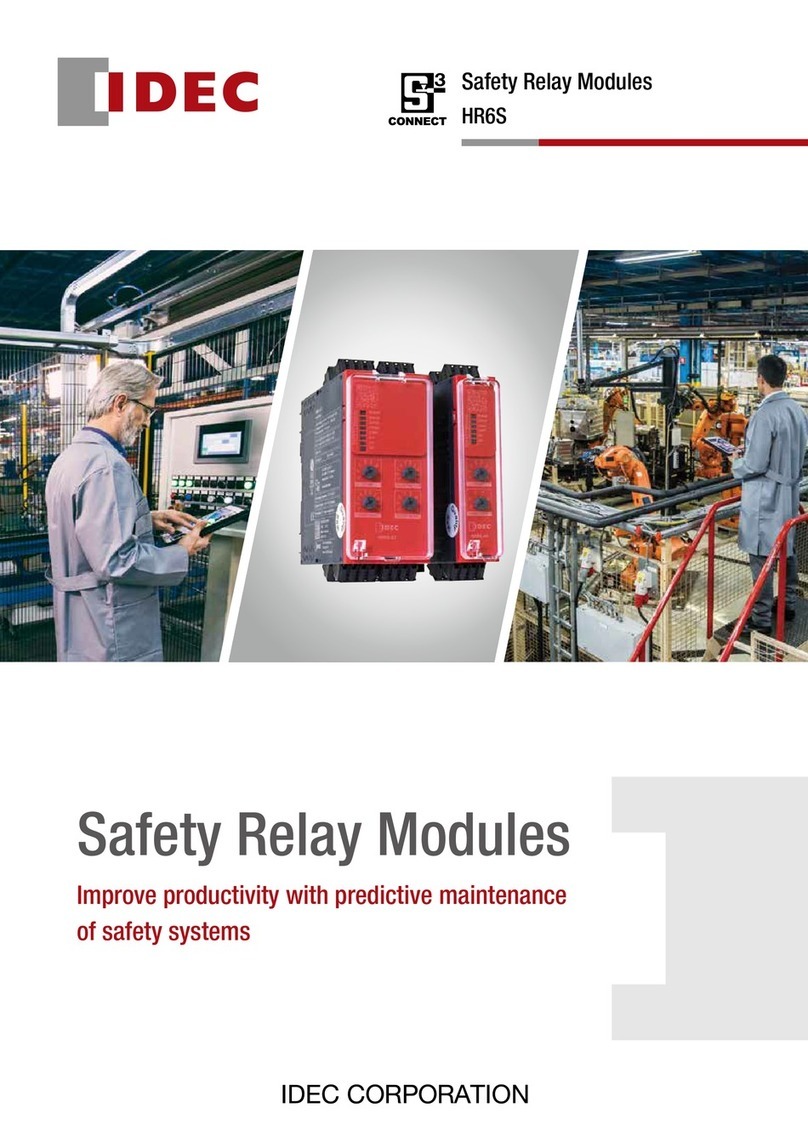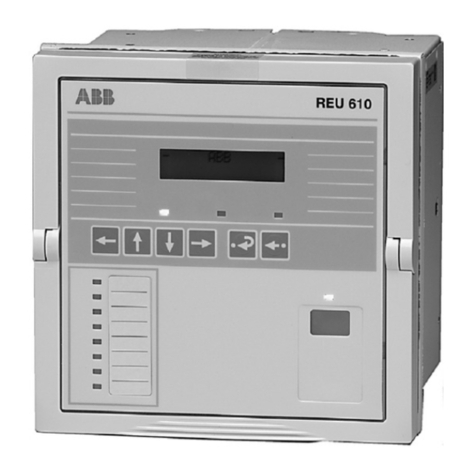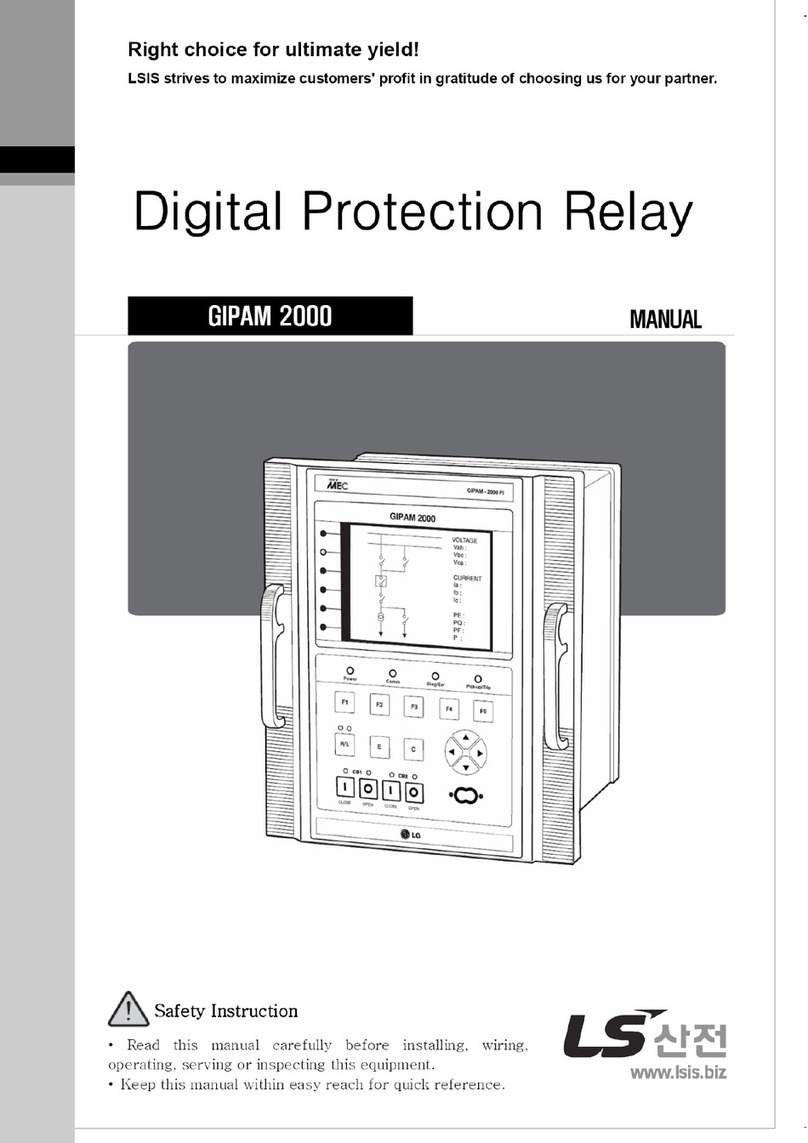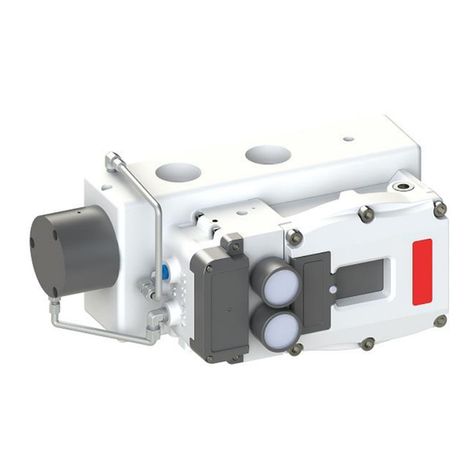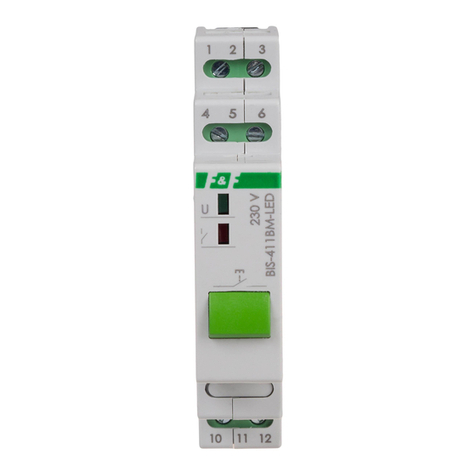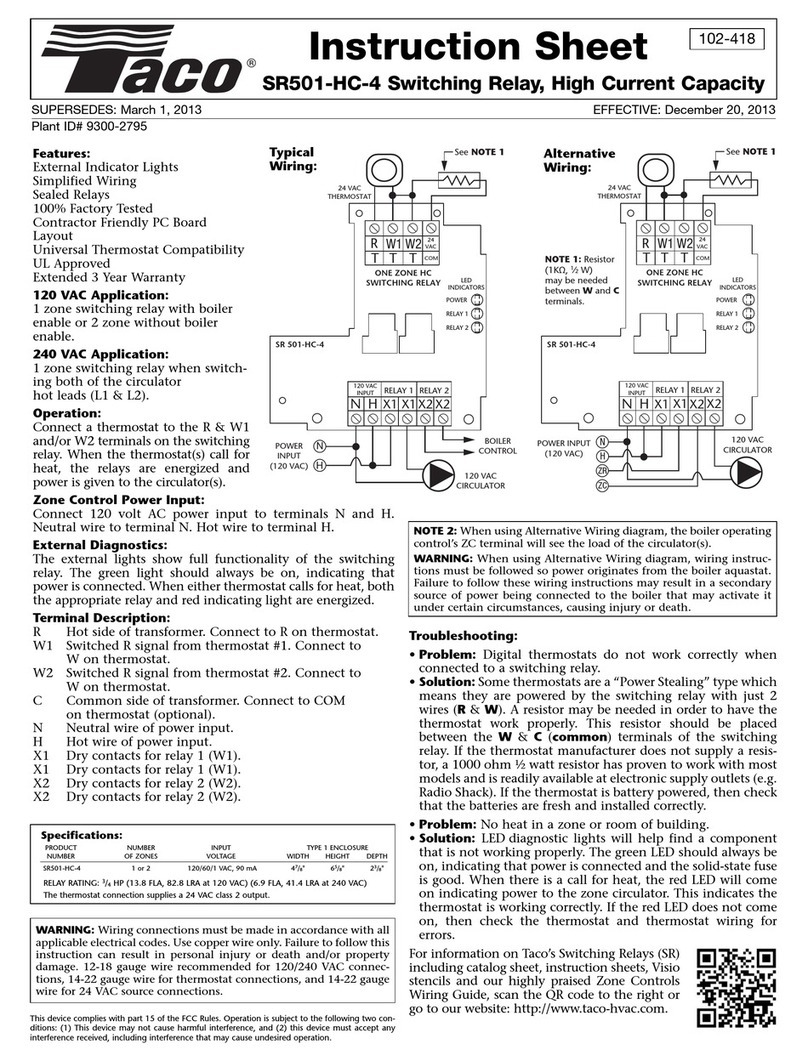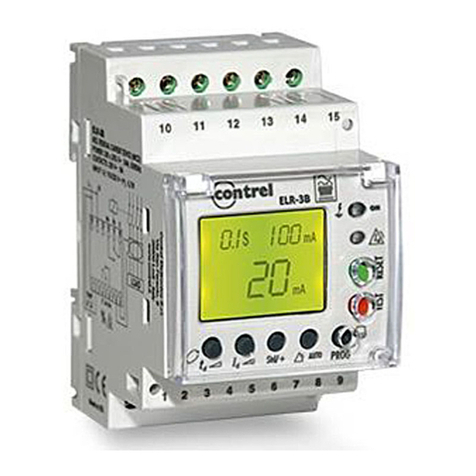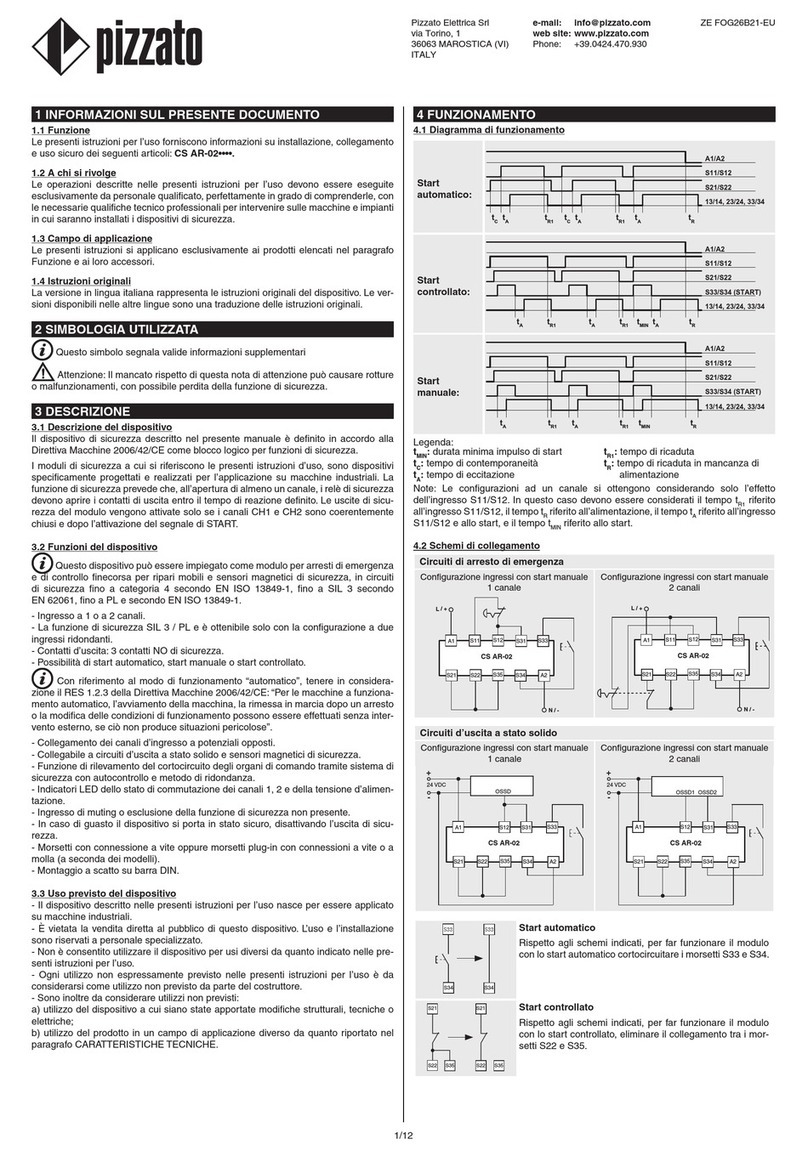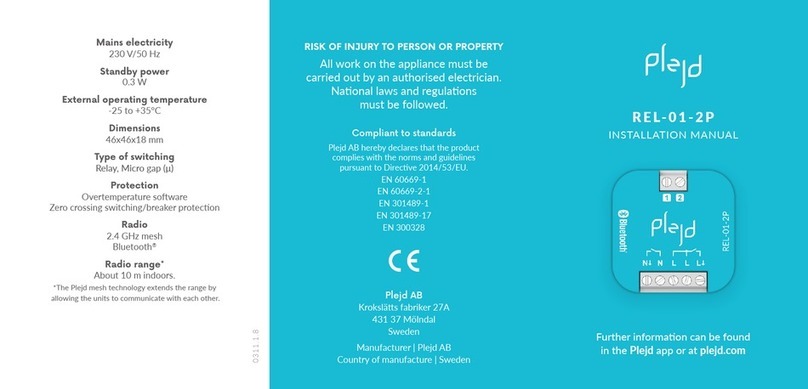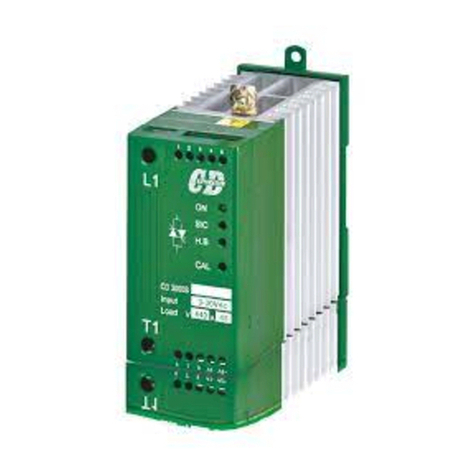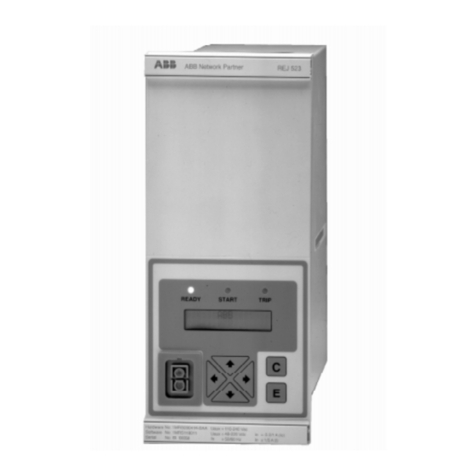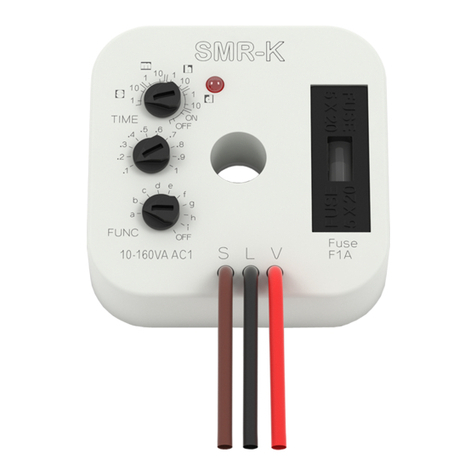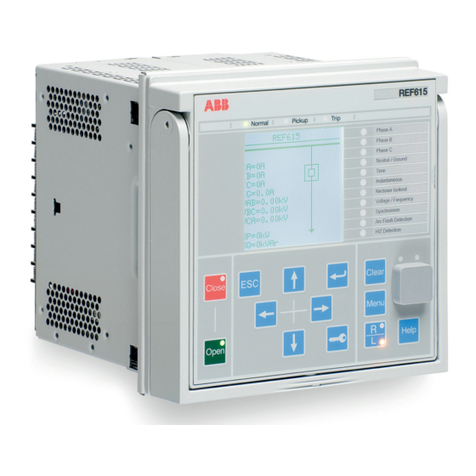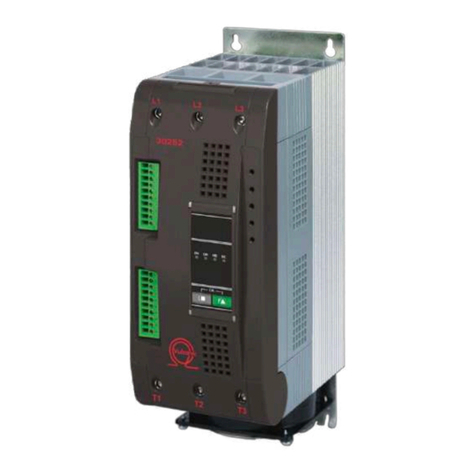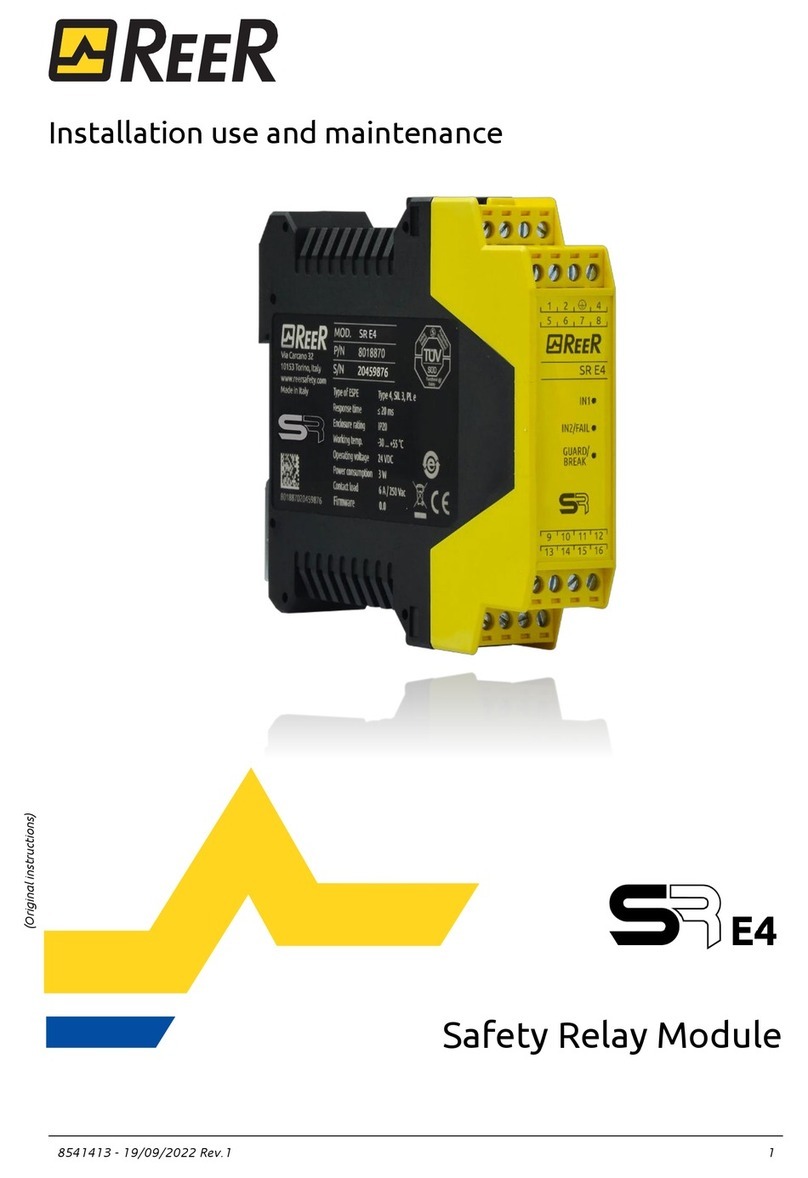IDEC SmartRelay FL1A-H12RCE User manual

IDEC SmartRelay
Manual
March 2001
www.idec.com

Copyright © 2001 IDEC IZUMI CORPORATION All rights reserved
The reproduction, transmission or use of this document or its contents is not permitted
without express written authority. Offenders will be liable for damages. All rights
reserved, in particular in the event of a patent being granted or the registration of a
utility model or design.
Disclaimer of Liability
We have checked the contents of this manual for compliance with the hardware and
software described. Nevertheless, discrepancies may exist. However, the data in this
manual is reviewed regularly and any necessary corrections will be included in
subsequent editions. Suggestions for improvement are welcomed.

iii
IDEC SmartRelay User’s Manual
Contents
1 Getting to Know IDEC SmartRelay 1-1
2 Installing and Wiring IDEC SmartRelay 2-1
2.1 Installing/Removing IDEC SmartRelay 2-2
2.2 Wiring IDEC SmartRelay 2-4
2.2.1 Connecting the power supply 2-4
2.2.2 Connecting IDEC SmartRelay’s inputs 2-6
2.2.3 Connecting outputs 2-10
2.3 Switching IDEC SmartRelay On/Resumption
of Power Supply 2-12
3Programming IDEC SmartRelay 3-1
3.1 Connectors 3-2
3.2 Blocks and Block Numbers 3-4
3.3 From the Circuit Diagram to
IDEC SmartRelay 3-7
3.4 The 4 Golden Rules for Working with IDEC
SmartRelay 3-10
3.5 Overview of IDEC SmartRelay’s Menus 3-12
3.6 Entering and Starting a Program 3-13
3.6.1 Switching to memory cartridge 3-13
3.6.2 First program 3-14
3.6.3 Entering a program 3-16
3.6.4 Second program 3-23

Contents
iv IDEC SmartRelay User’s Manual
3.6.5 Deleting a block 3-30
3.6.6 Deleting a number of interconnected blocks 3-31
3.6.7 Correcting typing errors 3-32
3.6.8 “?“on the display 3-32
3.6.9 Deleting a program 3-33
3.7 Storage Space and Size of a Circuit 3-34
4 IDEC SmartRelay Functions 4-1
4.1 Constants and Connectors –Co 4-2
4.2 List of General Functions –GF 4-4
4.2.1 AND 4-6
4.2.2 AND with RLO edge detection 4-6
4.2.3 NAND (AND Not) 4-7
4.2.4 NAND with RLO edge detection 4-8
4.2.5 OR 4-8
4.2.6 NOR (OR Not) 4-9
4.2.7 XOR (exclusive OR) 4-10
4.2.8 NOT (negation, inverter) 4-10
4.3 Fundamentals of Special Functions 4-11
4.3.1 Description of the inputs 4-11
4.3.2 Time response 4-12
4.3.3 Clock buffering 4-13
4.3.4 Retentivity 4-13
4.3.5 Degree of protection 4-14
4.3.6 Gain and offset calculation for analog values 4-14

Contents
v
IDEC SmartRelay User’s Manual
4.4 List of Special Functions –SF 4-15
4.4.1 On delay 4-18
4.4.2 Off delay 4-20
4.4.3 On/Off delay 4-22
4.4.4 Retentive on delay 4-24
4.4.5 Latching relay 4-26
4.4.6 Current impulse relay 4-28
4.4.7 Interval time-delay relay –pulse output 4-29
4.4.8 Edge-triggered interval time-delay relay 4-30
4.4.9 Seven-day time switch 4-31
4.4.10 Twelve-month time switch 4-36
4.4.11 Up/Down counter 4-38
4.4.12 Operating hours counter 4-41
4.4.13 Symmetrical clock pulse generator 4-44
4.4.14 Asynchronous pulse generator 4-45
4.4.15 Random generator 4-46
4.4.16 Frequency trigger 4-48
4.4.17 Analog trigger 4-50
4.4.18 Analog comparator 4-53
4.4.19 Stairwell light switch 4-57
4.4.20 Dual-function switch 4-59
4.4.21 Message texts 4-61
5 Parameterizing IDEC SmartRelay 5-1
5.1 Switching to Parameterization Mode 5-2
5.1.1 Parameters 5-2

Contents
vi IDEC SmartRelay User’s Manual
5.1.2 Selecting a parameter 5-3
5.1.3 Changing a parameter 5-4
5.2 Setting the Time (FL1A-…C…) 5-7
6 IDEC SmartRelay Memory Cartridge 6-1
6.1 Overview of the Memory Cartridge 6-2
6.2 Removing and Inserting Memory
Cartridge 6-2
6.3 Copying a Program from IDEC SmartRelay to
the Memory Cartridge 6-5
6.4 Copying from the Memory Cartridge to
IDEC SmartRelay 6-6
7 IDEC SmartRelay Software 7-1
7.1 Possible Applications for IDEC SmartRelay
Software 7-2
7.2 Connecting IDEC SmartRelay to PC 7-3
7.3 Transfer Settings 7-4
8 Applications 8-1
8.1 Stairwell or Hall Lighting 8-2
8.1.1 Demands on stairwell lighting 8-2
8.1.2 Previous solution 8-2
8.1.3 Lighting system with IDEC SmartRelay 8-3

Contents
vii
IDEC SmartRelay User’s Manual
8.1.4 Special features and enhancement options 8-6
8.2 Automatic Door 8-7
8.2.1 Demands on an automatic door 8-7
8.2.2 Previous solution 8-8
8.2.3 Door control system with IDEC SmartRelay 8-8
8.2.4 Special features and enhancement options 8-11
8.2.5 Enhanced FL1A-H10RCB solution 8-11
8.3 Ventilation System 8-14
8.3.1 Demands on a ventilation system 8-14
8.3.2 Advantages of using IDEC SmartRelay 8-16
8.4 Industrial Gate 8-18
8.4.1 Demands on the gate control system 8-18
8.4.2 Previous solution 8-19
8.4.3 Enhanced IDEC SmartRelay solution 8-21
8.5 Fluorescent Lights 8-22
8.5.1 Demands on the lighting system 8-22
8.5.2 Previous solution 8-23
8.5.3. Fluorescent light control with FL1A-H10RCB 8-24
8.6 Water Pump 8-26
8.6.1 Demands on the control system of a rainwater
Pump 8-27
8.6.2 Previous solution 8-27
8.6.3 Rainwater pump with FL1A-H10RCB 8-28
8.6.4 Special features and enhancement options 8-29
8.7 Further Potential Applications 8-30

Contents
viii IDEC SmartRelay User’s Manual
A Technical Specifications A-1
A.1 General Technical Specifications A-1
A.2 Technical Specifications: A-3
FL1A-H10RCB, FL1A-B10RCB
A.3 Technical Specifications: A-6
FL1A-H12RCE, FL1A-H10RCA,
FL1A- B10RCA
A.4 Technical Specifications: A-9
FL1A-H12RCE, FL1A-B12RCE
B Determining Memory Requirements B-1
C Determining the Cycle Time C-1
D IDEC SmartRelay Without a Display D-1
E IDEC SmartRelay Menu Structure E-1
F Order Numbers F-1
G Abbreviation G-1

i
IDEC SmartRelay User’s Manual
Welcome to IDEC SmartRelay
Dear customers,
Thank you for purchasing IDEC SmartRelay, and congratulations
on your decision. In IDEC SmartRelay you have acquired a logic
module that meets the stringent quality requirements of ISO9001.
IDEC SmartRelay is universal in application. Its comprehensive
functionality and great ease of use make it a highly cost-efficient
solution for virtually any application.
IDEC SmartRelay documentation
This IDEC SmartRelay manual tells you how to install, program
and use IDEC SmartRelay.
You can find information on wiring in the IDEC SmartRelay
manual as well as in the IDEC SmartRelay product information
that is supplied with each device. You can get further information
on programming IDEC SmartRelay via the PC in the WindLGC
online help system. WindLGC is the IDEC SmartRelay
programming software for PCs. It runs under WINDOWS and will
help you get to know IDEC SmartRelay and to write, test, print out
and archive programs independently of IDEC SmartRelay.
Guide to the manual
We have subdivided this manual into 9 chapters:
•Getting to Know IDEC SmartRelay
•Installing and Wiring IDEC SmartRelay
•Programming IDEC SmartRelay
•IDEC SmartRelay Functions
•Parameterizing IDEC SmartRelay
•IDEC SmartRelay’s Memory Cartridge
•IDEC SmartRelay Software
•Applications
•Appendices

Welcome to IDEC SmartRelay
ii IDEC SmartRelay User’s Manual
Safety guidelines
This manual contains notices which you should observe to ensure
your own personal safety, as well as to protect the product and
connected equipment. These notices are highlighted in the
manual by a warning triangle and are marked as follows
according to the level of danger:
!Danger Indicates that death, severe personal injury or substantial damage to
property will result if proper precautions are not taken.
!Warning Indicates that death, severe personal injury or substantial damage to
property can result if proper precautions are not taken.
!Caution Indicates that personal injury or damage to property can result if
proper precautions are not taken.
Note Draws your intention to particularly important information on the
product, handling the product, or to a particular part of the
documentation.
!Warning Only qualified personnel should be allowed to install and work on
this equipment. Qualified personnel are defined as persons who are
authorized to commission, to ground and to tag circuits, equipment
and systems in accordance with established safety practices and
standards.
!Warning This device may only be used for the applications described in the
catalog and the technical description, and only with non-IDEC
devices or components if they have been approved or
recommended by IDEC.
This product can only function correctly and safely if it is transported,
stored, set up, and installed correctly, and operated and maintained
as recommended.

1-1
IDEC SmartRelay User’s Manual
1 Getting to Know IDEC
SmartRelay
What is IDEC SmartRelay ?
IDEC SmartRelay is the universal logic module from IDEC.
IDEC SmartRelay integrates:
•Control functions
•An operating and display unit
•Power supply
•An interface for Memory Cartridges and a PC Cable
•Ready–to–use general functions that are often required
in day–to–day operation, such as functions for on/off
delays and current impulse relays
•Time switch
•Binary markers
•Inputs and outputs according to the device type
What can IDEC SmartRelay do?
You can use IDEC SmartRelay for domestic and
installation engineering tasks (e.g. stairway lighting,
external lighting, sun blinds, shutters, shop window lighting
etc.), switch cabinet engineering and mechanical and
apparatus engineering (e.g. gate control systems,
ventilation systems, or rainwater pumps etc.).

Getting to Know IDEC SmartRelay
1-2
IDEC SmartRelay User’s Manual
What device types are available?
There are IDEC SmartRelay models for 12V DC, 24V DC,
24V AC and 100-240V AC as:
•FL1A-H10RCA, FL1A-H10RCB, FL1A-B10RCA and
FL1A-B10RCB with 6 inputs and 4 outputs with
dimensions of 72 x 90 x 55 mm
•FL1A-B10…, FL1A-B12…without a display with
dimensions of 72 x 90 x 55 mm
•FL1A-H12SND, FL1A-H12RCE and FL1A-B12RCE with
8 inputs (6 Digital inputs and 2 Analog inputs) and 4
outputs with dimensions of 72 x 90 x 55 mm
•IDEC SmartRelay includes 29 ready to use general and
special functions for program creation.
It’s your choice
The variety of options can be adapted very easily to your
own specific task.

Getting to Know IDEC SmartRelay
1-3
IDEC SmartRelay User’s Manual
How IDEC SmartRelay is structured
55
SmartRelay... variant
1
2
3
I7 I8
Q1 Q2 Q3 Q4
L1 N I4 I5 I6
I1 I2 I3
idec
3
72
4
6
5
1
2
4
3Output
Power upply
Input
Module haft with
cover
5
6
Control panel
(not with FL1A-B10 … , FL1A-
B12…)
LCD
(not with FL1A-B10 …, FL1A-,
B12…)
SmartRelay
35
90
How to recognize which IDEC SmartRelay model you
have: IDEC SmartRelay’s designation contains information
on various characteristics:
•10: Total I/Os
•12: Total I/Os
•R: Relay outputs (without R: Transistor output)
•C: Integrated seven–day time switch
•H: Variant with display
•B: Variant without display
We also use icons to describe the different types of IDEC
SmartRelay. They are used whenever information refers to
only some of the IDEC SmartRelay variants:
Standard variant with 6 or 8 inputs and 4 outputs with
dimensions of 72 x 90 x 55 mm
Standard variant without a display with 6 or 8 inputs and
4 outputs with dimensions of 72 x 90 x 55 mm
IDEC SmartRelay…variant
idec SmartRelay

Getting to Know IDEC SmartRelay
1-4
IDEC SmartRelay User’s Manual
Variants The following different variants of IDEC SmartRelay are
available:
Symbol Type No. Outputs Type
FL1A-H12RCE * 4 x 230 V; 10A Relay
FL1A-H12SND * 4 x 24 V; 0.3 A Transistor
FL1A-H10RCA 4 x 230 V; 10 A Relay
FL1A-H10RCB 4 x 230 V; 10 A Relay
FL1A-B12RCE * 4 x 230 V; 10 A Relay
FL1A-B10RCA 4 x 230 V; 10A Relay
FL1A-B10RCB 4 x 230 V; 10A Relay
*: Also with analog inputs
Certification, recognition and approval
IDEC SmartRelay has UL, CSA and FM certification.
•UL listing mark
Underwriters Laboratories (UL) to
UL 508 standard, file no. E116536
•CSA Certification Mark
Canadian Standard Association (CSA) to
standard C22.2 No. 142, file no. LR 48323
•FM approval
Factory Mutual (FM) Approval to
Standard Class Number 3611, Class I, Division 2,
Group A, B, C, D

Getting to Know IDEC SmartRelay
1-5
IDEC SmartRelay User’s Manual
!Warning Personal injury and material damage may be
incurred.
In potentially explosive areas, personal injury or
property damage can result if you withdraw a
connector while the system is in operation.
Always ensure that the system is off
before you disconnect IDEC SmartRelay plug
connections and associated components in
potentially explosive areas.
IDEC SmartRelay carries CE marking, complies with the
VDE 0631 and IEC 1131 standards and has interference
suppression to EN 55011 (limit class B).
Shipbuilding certification has been granted.
•ABS - American Bureau of Shipping
•BV - Bureau Veritas
•DNV - Det Norske Veritas
•GL - Germanischer Lloyd
•LRS - Lloyds Register of Shipping
•PRS - Polski Rejestr Statków
IDEC SmartRelay can therefore be used both in industry
and at home.
Marking for Australia
The marking shown on the left meets the requirements of
the AS/NZS 2064 Standard (Class A).

Getting to Know IDEC SmartRelay
1-6
IDEC SmartRelay User’s Manual

2-1
IDEC SmartRelay User’s Manual
2 Installing and Wiring IDEC
SmartRelay
General guidelines
You should keep to the following guidelines when you
install and wire your IDEC SmartRelay:
•Ensure that you comply with all the valid and mandatory
standards when wiring your IDEC SmartRelay device.
You should also heed any national and regional
regulations when installing and operating the devices.
Contact the relevant authorities to find out the standards
and regulations that apply in your specific case.
•Use wires with the appropriate cross–section for the
amount of current involved. You can wire IDEC
SmartRelay using wires with a cross–section of
between 1.5 mm2and 2.5 mm2(see Section 2.2).
•Don’t screw the connectors too tightly. The maximum
torque is 0.5 Nm (see Section 2.2).
•Keep wiring distances as short as possible. If longer
wires are necessary, a shielded cable should be used.
You should lay wires in pairs: a neutral conductor
together with a phase conductor or signal conductor.
•Isolate AC wiring and high–voltage DC wiring with rapid
operating sequences from low–voltage signal wiring.
•Ensure that the wires have the required strain relief.
•Provide suitable over voltage protection for wires that
could be vulnerable to lightning.
•Do not connect an external power supply to an output
load parallel to a DC output. This can result in reverse
current at the output unless you have a diode or a
similar block in your configuration.
Note IDEC SmartRelay must be installed and wired by a trained technician
who knows and complies with both the universally applicable engineering
rules and the regulations and standards that apply in specific cases.

Installing and Wiring IDEC SmartRelay
2-2
IDEC SmartRelay User’s Manual
2.1 Installing/Removing IDEC SmartRelay
Dimensions
The dimensions of IDEC SmartRelay comply with
DIN 43880.
IDEC SmartRelay must be snapped onto a DIN rail with a
width of 35 mm to DIN EN 50022.
Width of IDEC SmartRelay:
•IDEC SmartRelay is 72 mm wide, which corresponds to
the size of all modules.
Note We will show you how to install and uninstall IDEC SmartRelay
with the aid of an illustration of the FL1A-H10RCB. The
measures described also apply to all other IDEC SmartRelay
modules.
InstallingTo install IDEC SmartRelay on a DIN rail, proceed as
follows:
1. Place IDEC SmartRelay on the rail
2. Swivel it onto the rail so that the snap catch on the back
of IDEC SmartRelay engages.
Depending on the type of DIN rail used, the snapping
mechanism may be a bit stiff. If it is too stiff and IDEC
SmartRelay won’t snap on, you can pull the snap catch
down a little as you do when uninstalling IDEC SmartRelay
(as described below).

Installing and Wiring IDEC SmartRelay
2-3
IDEC SmartRelay User’s Manual
Removing
To remove IDEC SmartRelay, proceed as follows:
1. Insert a screwdriver in the hole shown in the picture at
the lower end of the snap catch, and pull the snap catch
downwards.
1
2
2. Swivel it away from the DIN rail.

Installing and Wiring IDEC SmartRelay
2-4
IDEC SmartRelay User’s Manual
2.2 Wiring IDEC SmartRelay
Use a screwdriver with a 3 mm head to wire IDEC
SmartRelay.
You don’t need wire end ferrules for the connectors. You
can use wires up to the following sizes:
•1 x 2.5 mm2
•2 x 1.5 mm2 for each second connector compartment
Connecting torque: 0.4...0.5 Nm or 3...4 LBin
Note Install IDEC SmartRelay in a distribution box or control
cabinet, ensuring that the connectors are covered. If they are
not, there is a danger of touching live parts.
2.2.1 Connecting the Power Supply
FL1A-H10RCB and FL1A-B10RCB are suitable for line
voltages with a rating of 100V AC and 240V AC. Other
Types are suitable for 12V DC, 24V DC or 24V AC supply
voltage. Note the information on connection in the product
information document shipped with your device and the
technical specifications in Appendix A relating to the
permissible voltage tolerances, line frequencies and
current inputs.
Note Power failure might result in a voltage spike after power
restoration, which may affect certain edge-triggered function
blocks.
This manual suits for next models
6
Table of contents
Other IDEC Relay manuals
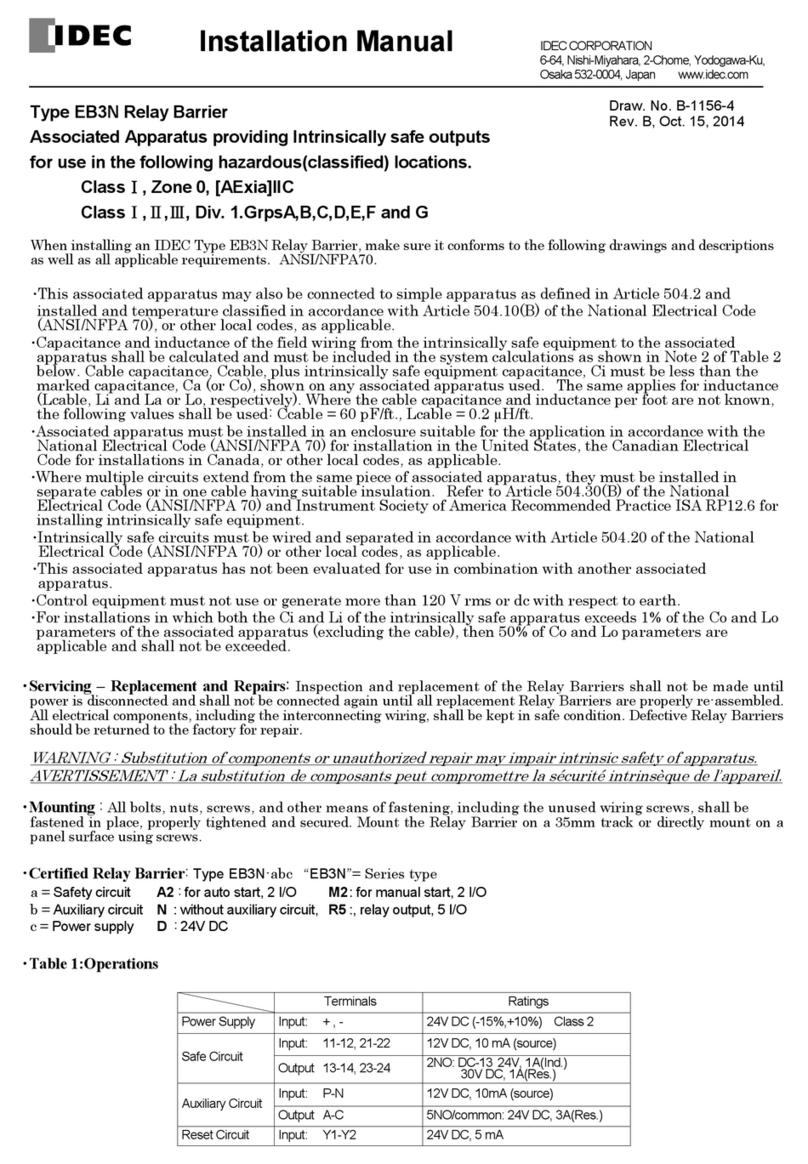
IDEC
IDEC EB3N User manual
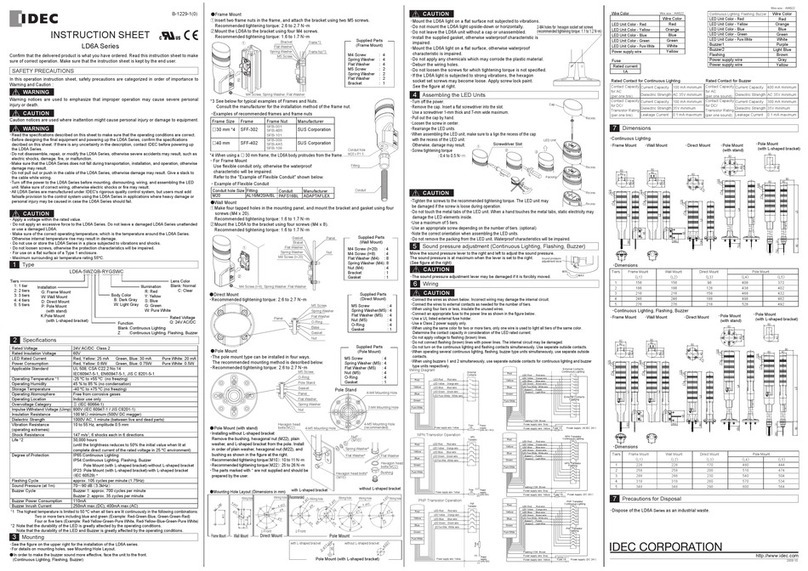
IDEC
IDEC LD6A Series User manual
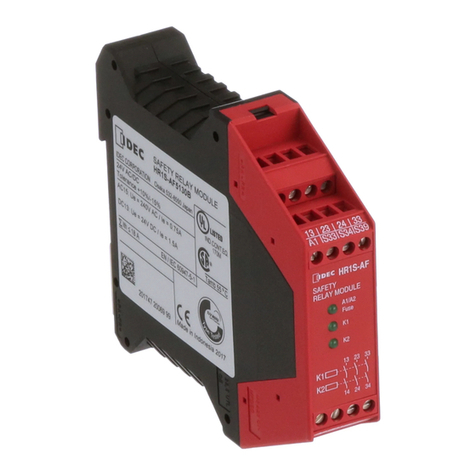
IDEC
IDEC HR1S-AF 5130B/PB User manual
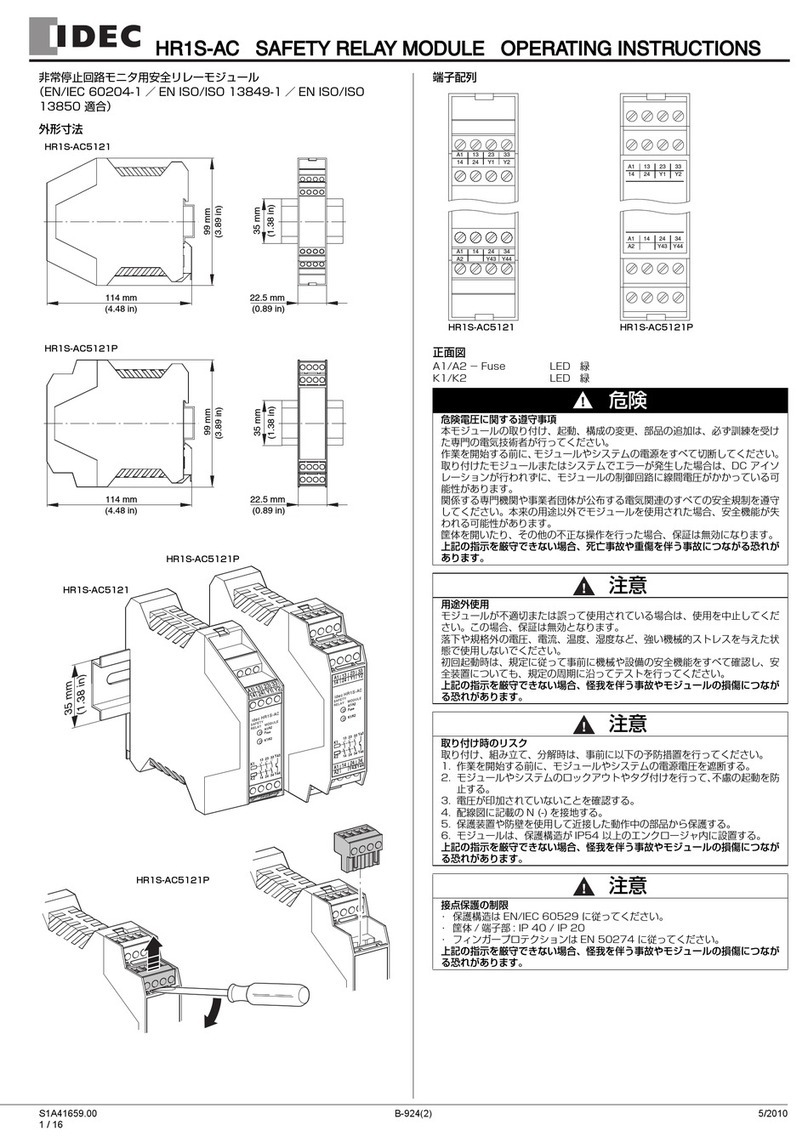
IDEC
IDEC HR1S-AC User manual
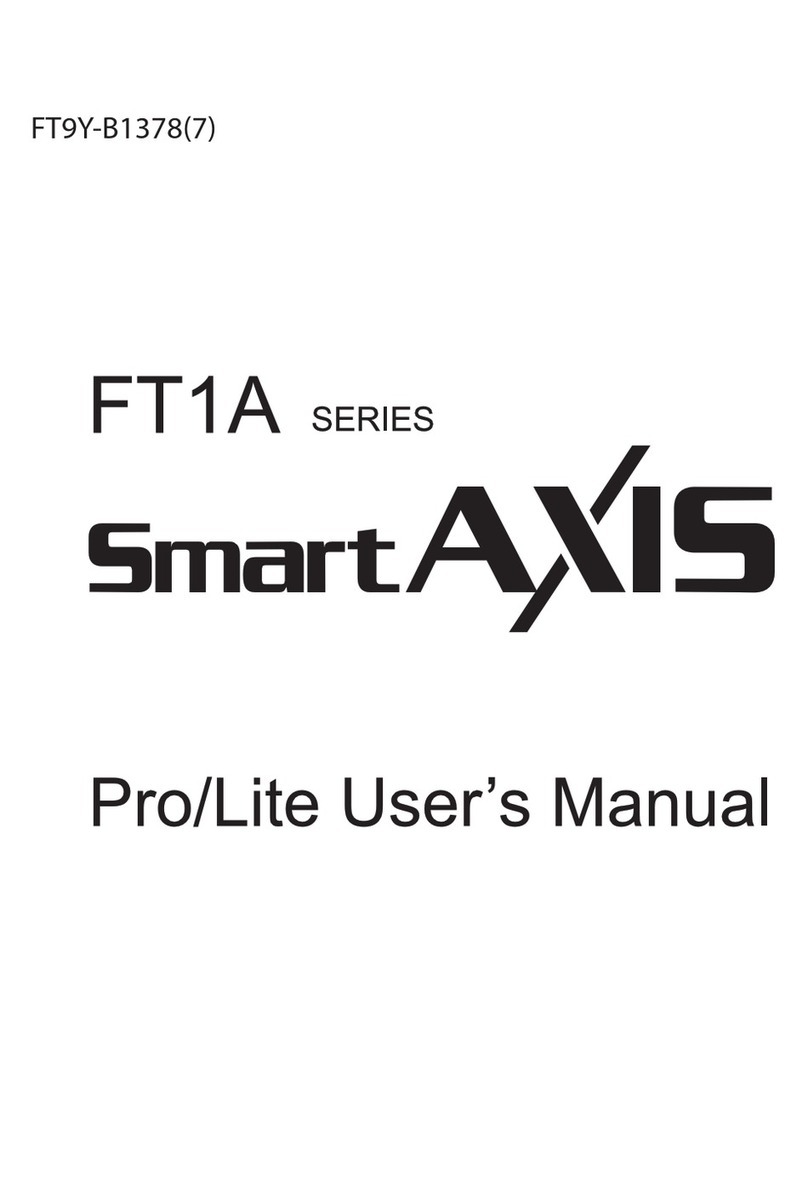
IDEC
IDEC SmartAXIS FT9Z-1A01 User manual
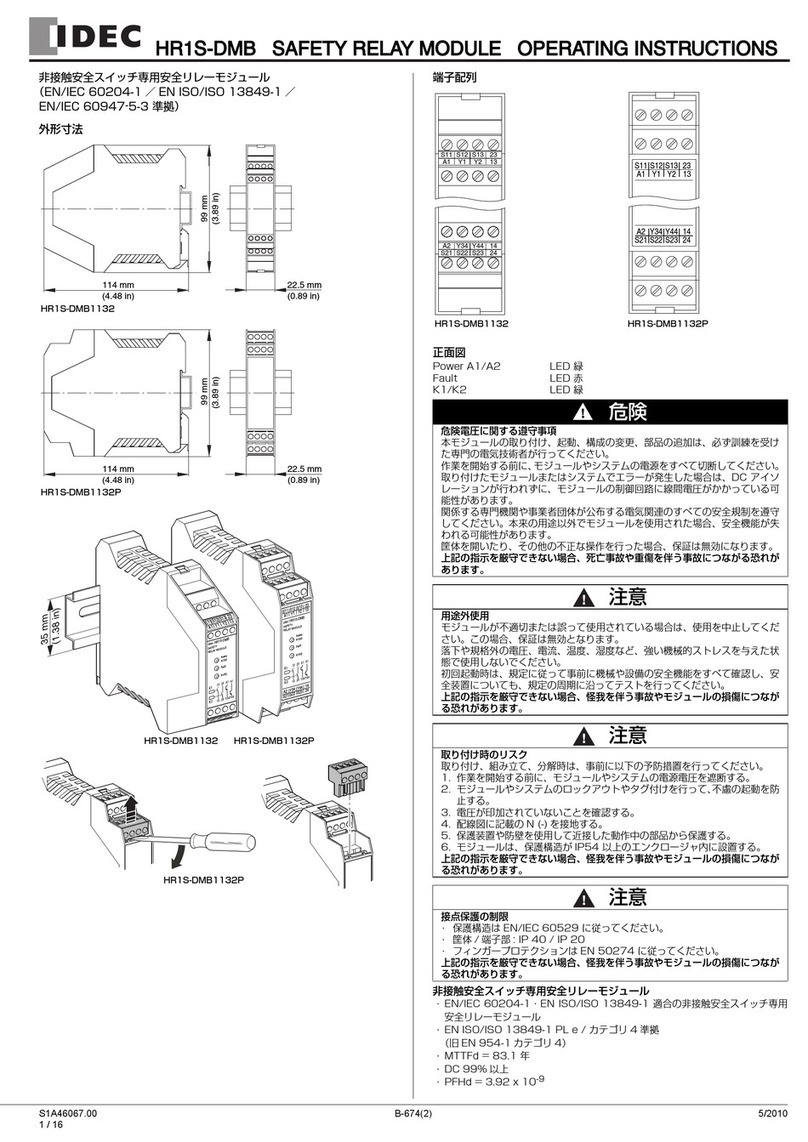
IDEC
IDEC HR1S-DMB Series User manual
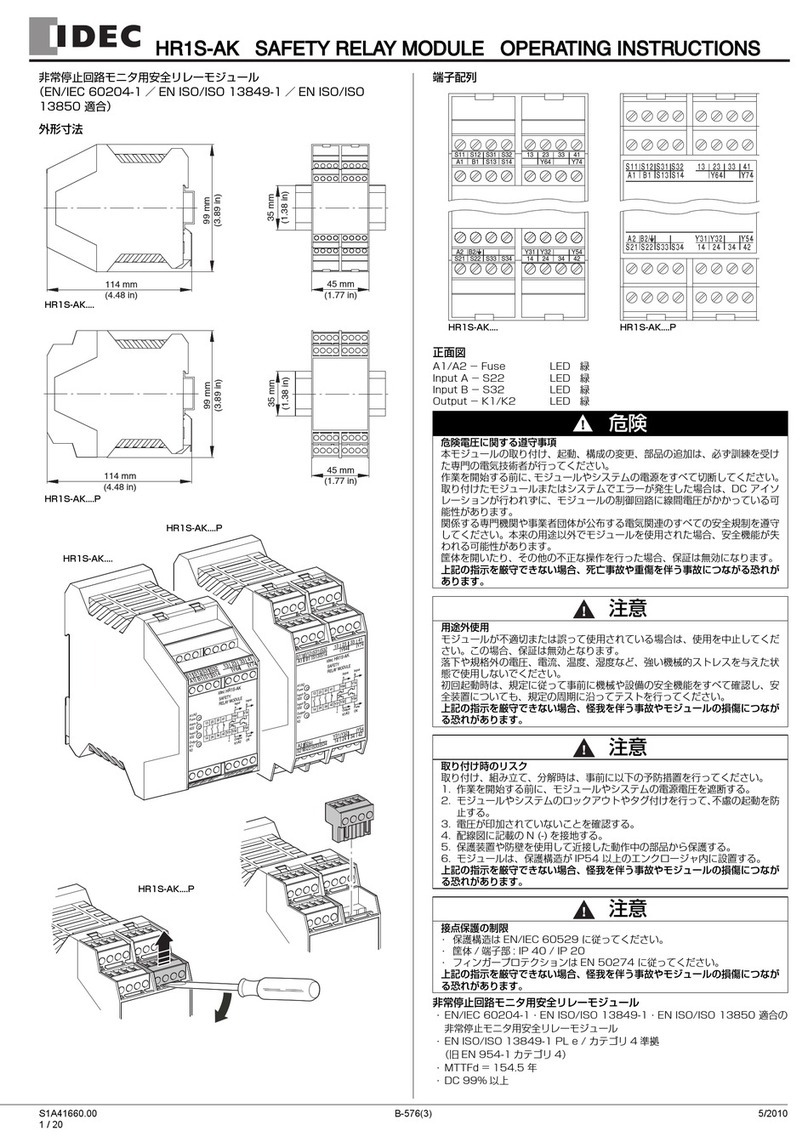
IDEC
IDEC HR1S-AK User manual
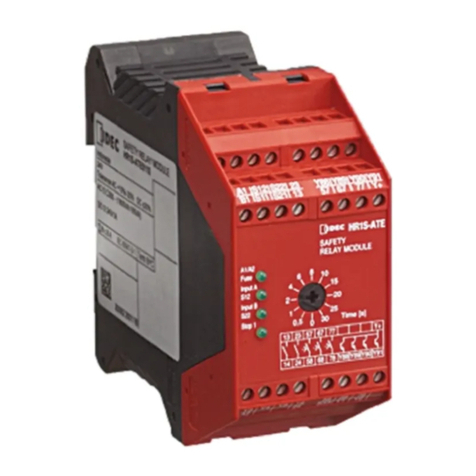
IDEC
IDEC HR1S-ATE User manual
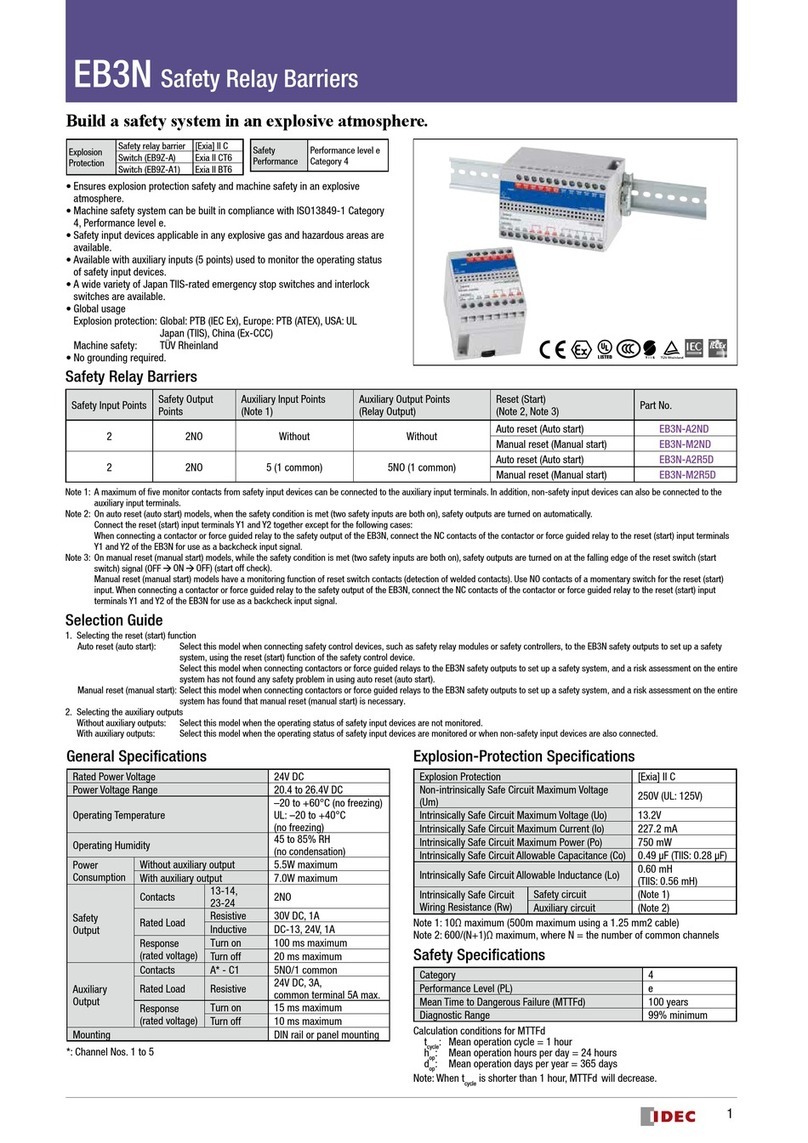
IDEC
IDEC EB3N User manual
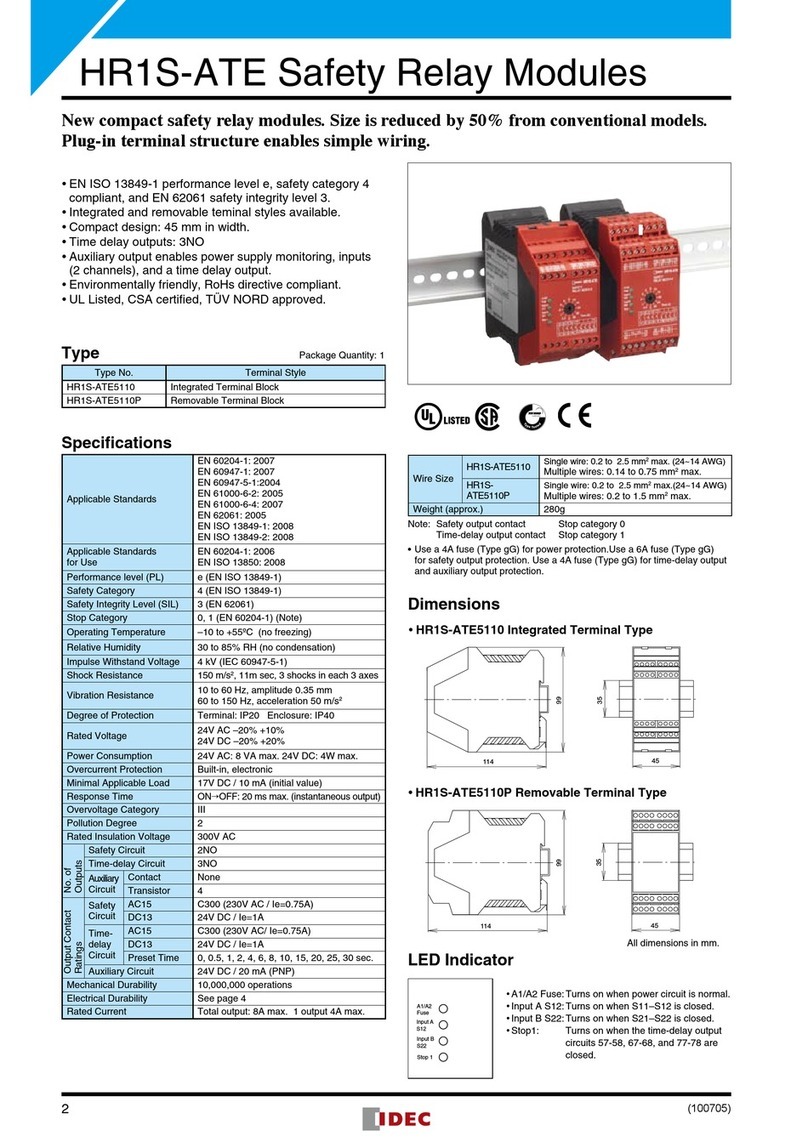
IDEC
IDEC HR1S-ATE User manual
